
Asus Vivobook 17X
MSRP $1,000.00
“The Asus Vivobook 17X’s poor display spoils what would be a solid budget 17-inch laptop.”
Pros
- Solid productivity performance
- Good keyboard
- Attractive price
- Reasonable weight
Cons
- Poor display
- Flimsy build quality
- The touchpad could be bigger
The largest mainstream machines available today, 17-inch laptops, offer the most screen real estate for multitasking and creative work. They also come with larger chassis. But they’re not all built the same, with some aiming at budget prices and productivity performance and others packing in the fastest components and best displays aimed at creators.
The Asus Vivobook 17X belongs in the former group. It offers a low price starting at $630 while maxing out at $1,000, with fast 45-watt Intel 12th-gen CPUs available. But it’s limited to integrated Intel graphics, meaning it won’t churn through GPU-dependent creative apps or hit high frame rates while gaming. The Vivobook 17X is an intriguing option when configured for around $700, but the build quality, display, and battery life make it hard to recommend at a higher price.
Asus Vivobook 17X specs
| Asus Vivobook 17X | |
| Dimensions | 15.72 inches x 10.01 inches x 0.78 inches |
| Weight | 4.63 pounds |
| Processor | Intel Core i3-1220P Intel Core i5-12500H Intel Core i7-12700H |
| Graphics | Intel Iris Xe |
| RAM | 8GB DDR4 12GB DDR4 16GB DDR4 |
| Display | 17.3-inch 16:9 Full HD (1920 x 1080) IPS |
| Storage | 256GB PCIe 3.0 SSD 512GB PCIe 3.0 SSD 1TB PCIe 3.0 SSD |
| Touch | No |
| Ports | 1 x USB-A 2.0 2 x USB-A 3.2 Gen 2 1 x USB-C 3.2 Gen 1 1 x HDMI 1.4 1 x 3.5mm audio jack |
| Wireless | Wi-Fi 6 and Bluetooth 5 |
| Webcam | 720p |
| Operating system | Windows 11 |
| Battery | 50 watt-hours |
| Price | $630+ |
The Vivobook 17X starts at $630 for a Core i3-1220P CPU, 8GB of RAM, and a 512GB SSD. At the high end is my $999 review unit, equipped with a Core i7-12700H CPU, 16GB of RAM, and a 1TB SSD. All models come with a 17.3-inc,h 16:9 Full HD (1920 x 1200) IPS display.
The most attractive configuration, though, is the $730 version with a Core i5-12500H, 12GB of RAM, and a 512GB SSD. I didn’t test this configuration, but it’s a decent value on paper.
The muted display
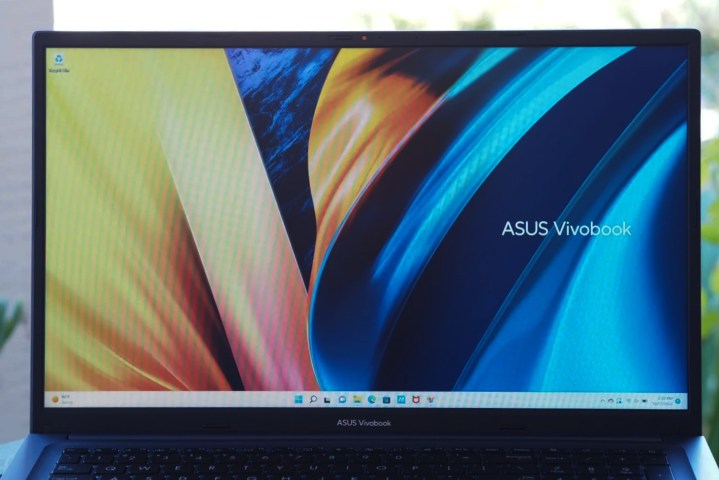
When you’re buying a 17-inch laptop, the standout feature is the display. It’s the whole point of buying such a large machine, and its quality has an oversized impact on the computing experience. Unfortunately, the Vivobook 17X display is well below average, certainly compared to midrange and premium laptops and even according to many budget machines we’ve reviewed in the last year or so.
The Asus is the least expensive 17-inch laptop we’ve tested in some time, but even without direct comparisons, I’m comfortable saying this is quite a poor display for this price.
This was obvious when I turned it on. It wasn’t very bright, and its colors were muted. The contrast also seemed low. Even judging it from the perspective of productivity work, I wasn’t impressed. It’s also an old-school 16:9 IPS display running at a mere Full HD (1920 x 1080) resolution. That’s not very sharp, with noticeable pixelation in text that’s made even less attractive thanks to the low contrast. And this display won’t even come close to meeting the needs of even entry-level creators.
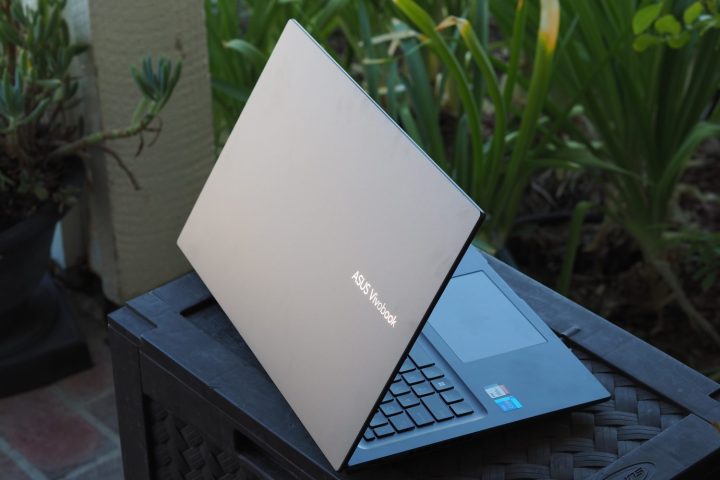
As I noted, we haven’t reviewed any other 17-inch budget laptops recently, but we can compare the display to those on some other reasonably priced laptops. Simply put, the Vivobook 17X display is the worst display we’ve seen in a while. It doesn’t hit our 300-nit brightness threshold, its 660:1 contrast ratio results in greys rather than blacks, and its colors are narrow and inaccurate.
The HP Envy 16 with the same CPU, RAM, and storage but with a much faster Nvidia GeForce RTX 3060 GPU and a spectacular higher-resolution OLED display is just $1,400 right now. Yes, that’s more money than my review unit, but it’s also a much faster machine with a display that’s in another league entirely.
| Brightness (nits) |
Contrast | sRGB gamut | AdobeRGB gamut | Accuracy DeltaE (lower is better) |
|
| Asus Vivobook 17X (IPS) |
278 | 660:1 | 65% | 48% | 3.39 |
| Asus Vivobook S 14 Flip (IPS) |
321 | 1,230:1 | 64% | 48% | 3.14 |
| Acer Swift 3 2022 (IPS) |
368 | 1,330:1 | 98% | 75% | 1.51 |
| HP Envy 16 (OLED) |
348 | 24,3010:1 | 100% | 97% | 0.74 |
The audio quality matched the display. Yes, the dual speakers were plenty loud, but the highs were grating and overpowered the mids and lows. There was also considerable distortion at full volume. You’ll want headphones or Bluetooth speakers for anything other than system sounds.
Look elsewhere for discrete graphics

Several manufacturers have been installing 45-watt Intel 12th-gen CPUs along with integrated Intel Iris Xe graphics, especially in 14-inch laptops. That’s a switch from the past where faster, more power-hungry CPUs were more typically installed with discrete GPUs for maximum performance. In a 17-inch machine like the Vivobook 17X, it’s a strange combination but still promises superior performance.
As it turns out, the Vivobook 17X did indeed provide excellent performance, especially for productivity workflows and less demanding creative tasks. It did well in CPU-intensive processes like our Handbrake test that encodes a 420MB video as H.265 and in Cinebench R23. If your creative work doesn’t involve applications that utilize the GPU to speed things up, then you’ll be happy with the laptop’s performance.
If you use applications that can use the GPU, though, like Adobe’s Creative Suite, then you’ll want to spend more money to match performance with display size. I provide both balanced and performance results using the Asus thermal management utility in the table below, but the settings made little difference.
Of course, the Vivobook 17X display isn’t well-suited for creative tasks, in any event, so looking at the laptop as a multitasking productivity workstation is the best bet. If you’re on the strictest budget, then the laptop can also handle some less demanding creative workflows. Given the integrated graphics, gaming will be limited to older games and esports titles and low resolutions with reduced graphical detail.
| Geekbench (single / multi) |
Handbrake (seconds) |
Cinebench R23 (single / multi) |
PCMark 10 Complete |
|
| Asus Vivobook 17X (Core i7-12700H) |
Bal: 1,698 / 8,339 Perf: 1,714 / 8,558 |
Bal: 93 Perf: 87 |
Bal: 1,681 / 11,083 Perf: 1,717 / 12,552 |
5,665 |
| HP Envy 16 (Core i9-12900H) |
Bal: 1,839 / 11,187 Perf: 1,811 / 11,387 |
Bal: 83 Perf: 84 |
Bal: 1,919 / 12,538 Perf: 1922 / 12,525 |
6,872 |
| Lenovo ThinkPad Z16 (Ryzen 7 Pro 6850H) |
Bal: 1,360 / 8,648 Perf: 1,365 / 8,679 |
Bal: 88 Perf: 87 |
Bal: 1,376 / 10,938 Perf: 1,374 / 11,553 |
6,260 |
| Dell XPS 15 9520 (Core i7-12700H) |
Bal: 1,470 / 9,952 Perf: 1,714 / 11,053 |
Bal: 100 Perf: 77 |
Bal: 1,509 / 11,578 Perf: 1,806 / 13,313 |
5,559 |
| Asus ZenBook Pro 14 Duo (Core i7-12700H) |
Bal: 1,829 / 10,819 Perf: N/A |
Bal: 94 Perf: 82 |
Bal: 1,793 / 12,046 Perf: N/A |
6,242 |
| LG Gram 16 2-in-1 (Core i7-1260P) |
Bal: 1,682 / 9,035 Perf: 1,686 / 9,479 |
Bal: 137 Perf: 113 |
Bal: 1,524 / 6,314 Perf: 1,663 / 8,396 |
5,404 |
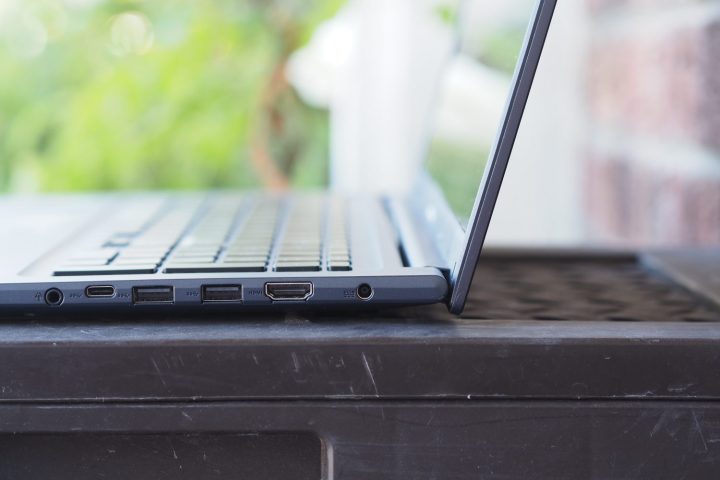
The Vivobook 17X was equipped with a 50-watt-hour battery, which is small for a fast CPU and 17-inch display, even in Full HD. As such, its battery life was below average across the board, hitting just five hours in our web browsing test, 10 hours in our video test (which isn’t terrible), and less than seven hours in the PCMark 10 Applications battery test.
Overall, the results don’t bode well for all-day battery life. The power brick isn’t huge, though, so carrying it around shouldn’t be a huge burden.
What a budget machine buys you
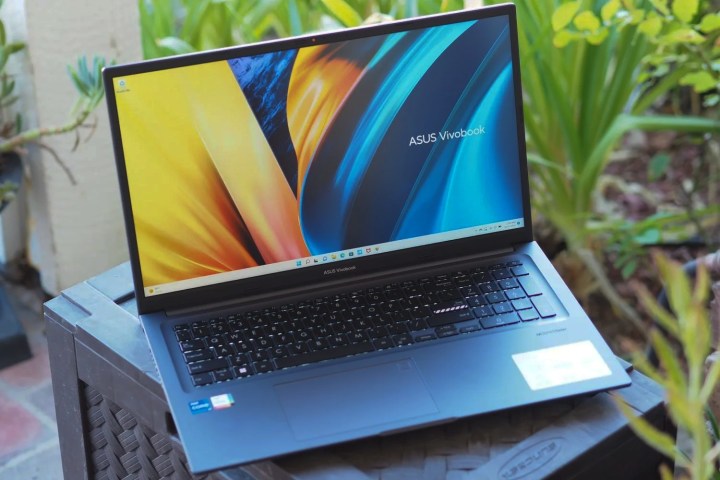
When you’re spending about $700 for a 17-inch laptop, you can’t expect an all-metal build with incredible rigidity. And that’s not what you get from the Vivobook 17X with its aluminum lid and plastic chassis. Instead, you get some bending in the lid and flexing in the keyboard deck. It’s not a cheap build by any means, but as I’ve stressed throughout this review, it’s more suitable at its lower prices.
If you’re going to spend $1,000 for a laptop, you’re creeping up into the territory of laptops like the HP Envy 16 that aren’t quite as large but are much better built. And the hinge is very tight, requiring two hands to open, but the lid still manages to be a bit wobbly.
The Vivobook 17X is a reasonably sized laptop, with thicker plastic display bezels that force a larger chassis than a tiny-bezel laptop like the (much more expensive) Dell XPS 17. The plastic construction has one significant benefit, and that’s a relatively low weight of 4.63 pounds.
The aluminum and carbon fiber XPS 17 weighs 5.34 pounds, and an all-aluminum 17-inch laptop like the (also much more expensive) MSI Creator Z17 is a hefty 6.79 pounds. The Vivobook 17X is also thin for a large inexpensive laptop at 0.78 inches compared to the XPS 17 at 0.77 inches.
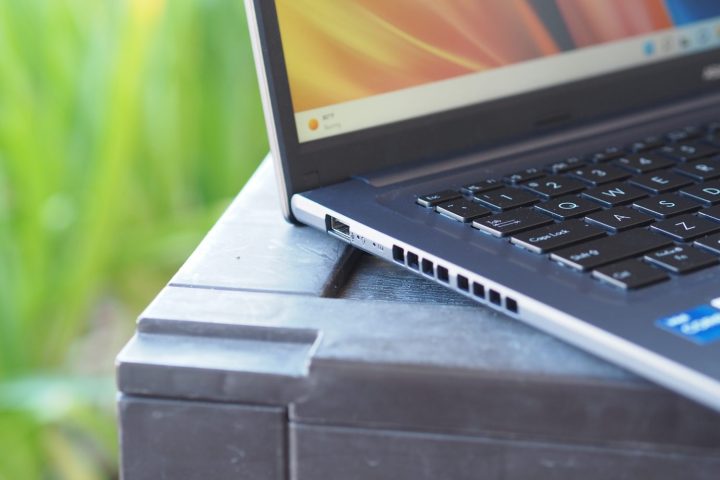
One interesting design element is the inclusion of Asus’s Antibacterial Guard treatment. The coating is applied to the entire laptop and uses silver ions to restrict bacterial growth by 99%. It doesn’t work against viruses like the ones that cause COVID-19, but it’s effective in keeping the laptop free of potentially disease-causing bacteria.
Aesthetically, the Vivobook 17X is rather plain. Its dark blue color is maintained throughout, except for the black keyboard, and there’s little bling. Even the chrome Vivobook logo isn’t the same refined version you’ll find on other contemporaries. As with some other Vivobooks, Asus incorporated its odd black and white stripe along the bottom of the Enter key, which doesn’t add much to the look but rather just distracts.
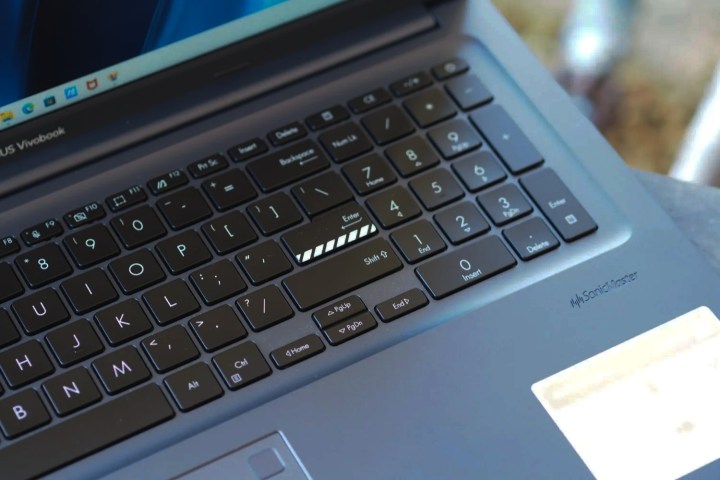
Asus included a very nice keyboard, with tons of key spacing even with the numeric keypad and sculpted keycaps. The switches are light and snappy with a comfortable bottoming action, and while they’re not as good as those on Dell’s XPS laptops, they’re excellent for an affordable machine. The touchpad is smaller than it could be, with plenty of available space on the palm rest.
Even so, it has a smooth, responsive surface with reliable Windows 11 multitouch gesture support and solid, quiet buttons. There’s no touch display option, which isn’t surprising.
There are plenty of ports available. The problem is that some of them are behind the curve. For example, the USB-C ports don’t support Thunderbolt 4 while the HDMI port is stuck at HDMI 1.4. You can get both Thunderbolt 4 and HDMI 2.0 or later in machines under $1,000, so the price is not an excuse here. Wireless connectivity is also behind, with Wi-Fi 6 and Bluetooth 5 rather than the newer and faster Wi-Fi 6E and Bluetooth 5.2.
Finally, Windows 11 Hello passwordless support is provided by a fingerprint reader embedded in the touchpad. That’s my least favorite location, as it takes away from available scrolling space. But it worked just fine.
Glaring weaknesses, but the price matters
The Vivobook 17X is a lot like the Asus Vivobook S 14 Flip: it’s far more attractive at its lower price points than at the $1,000 configuration that I reviewed. If you’re on a tight budget but need a large display, then the Vivobook 17X is a decent offering.
Its display isn’t nearly good enough nor is its build solid enough at its higher price. I don’t recommend the review unit, but the Vivobook 17X is worth a look at $730. Keep in mind — you really have to value that large screen, because otherwise, you’ll find plenty of better options for smaller laptops, even at that price.
Editors’ Recommendations
Credit: Source link


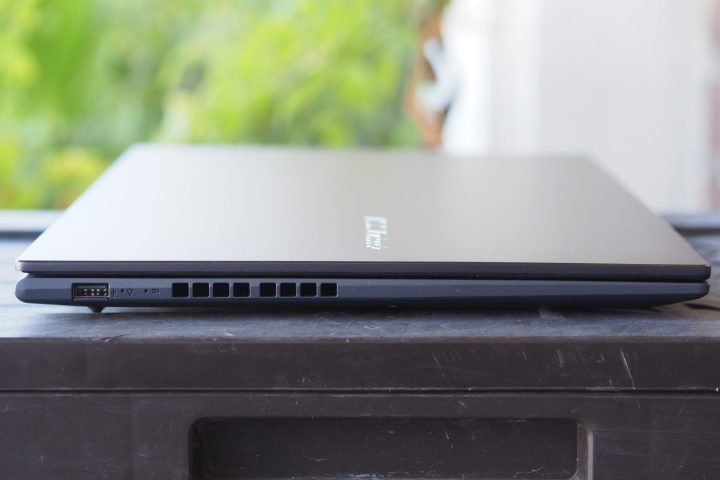
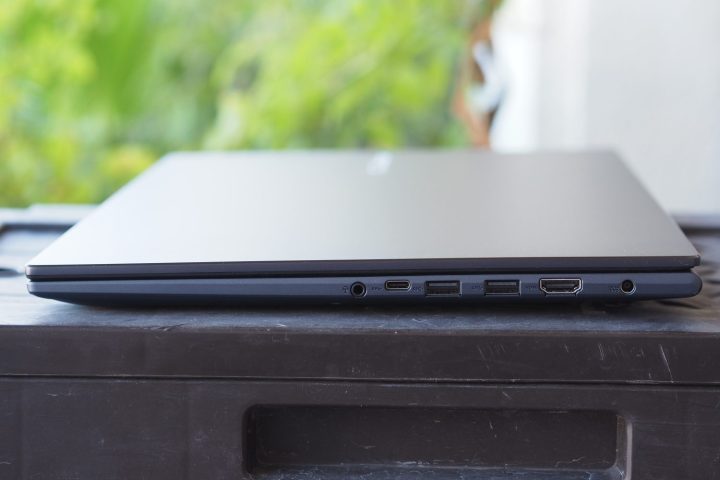
Comments are closed.